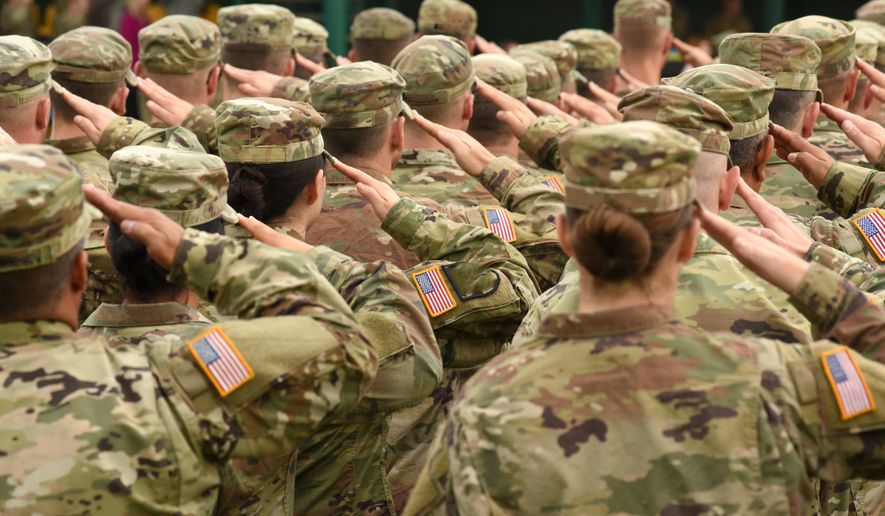The Pentagon is hoping to tap into Generation Z’s obsession with nostalgia — “Friends,” preppy clothes, Green Day albums on turntables — to address a major recruiting slump in the Army.
Military officials say they are bringing back the iconic “Be All You Can Be” recruiting slogan from the 1980s and 1990s, and not just because of mere sentimentalism.
The Army has confirmed that it will build an advertising campaign around the slogan over the coming months to help overcome its most severe recruiting challenges since the end of the draft in 1973.
“‘Be All You Can Be’ is the message for the moment and for the future,” said Laura DeFrancisco, a spokeswoman for the Chicago-based Army Enterprise Marketing Office.
“We are not ‘returning’ to ‘Be All You Can Be’; we are reinventing it to reposition the Army and to inspire the next generation of soldiers,” Ms. DeFrancisco said.
During the 1980s and 1990s, Army commercials featuring the “Be All You Can Be” slogan told potential recruits that they would “do more before 9 a.m. than most people do all day.”
SEE ALSO: Marine Corps to form new unit in Okinawa with missiles to take on China
The commercials typically featured male soldiers jumping out of airplanes or driving tanks.
Yet times have changed over the past 40 years, and not just because all Army jobs are now open to women.
“In the coming months, the Army will show the American public how we’re bringing this iconic brand forward to reintroduce the infinite possibilities of Army service,” Ms. DeFrancisco said.
Marketing specialists say the Army’s tactic of rolling out a slogan that’s older than most of the people they’re targeting is successful in the American advertising world.
Wendy Melillo, a communications professor at American University, said the “Be All You Can Be” message is part of the nation’s “collective advertising memory.”
“Advertisers periodically try new approaches but will periodically return to long-running ad campaigns that their brands are best known for,” Ms. Melillo told The Washington Times.
SEE ALSO: Pentagon drops mandatory COVID-19 vaccinations for troops
She said advertising styles are based on creative processes and work in the same manner as artistic or literary efforts. Admired and well-recognized campaigns are imitated.
“To stand out, capture attention or revive a stalled brand,” Ms. Melillo said, “advertisers will look to their glory days to generate new interest.”
Other brands also are capitalizing on the retromania of Gen Z, those born between 1997 and 2012.
Burger King has introduced a logo strikingly similar to the one the global restaurant chain used in the 1990s: paper crowns for customers.
The Army’s recruitment campaign also evokes the collective nostalgia of parents and grandparents, who are potential influencers.
“People will remember the slogan from the past, and it hopefully prompts past positive associations with the brand,” said Mathew Curtis, a communications professor at the University of Southern California.
The media environment has become much more diverse, said Mr. Curtis, noting the disappearance of TV shows that connected masses of people to the degree that “I Love Lucy” or “Monday Night Football” once did.
“Using nostalgia effectively connects with a broader section of the public much more effectively than alternatives such as using the current most popular influencer on Tik Tok,” Mr. Curtis said.
Recruiting shortage
The Army fell short of its 2022 recruiting goal by 25% and cut its total force projection by 10,000 soldiers. Defense Department officials say it has become harder to compete with the civilian labor market.
“We’re competing for talent just like all of the folks in industry are, and the job market is hot right now,” Army Secretary Christine Wormuth told CNBC. “Wages have gone up a lot, and that’s great for Americans, but it’s making it harder for us in the Army to compete.”
The Army has a workforce of about 460,000. Officials say only a small percentage of Americans are inclined to enlist on their own, and some are physically out of shape or otherwise unable to serve.
Defense Department officials also blame anemic enlistment numbers on the COVID-19 pandemic, which kept most recruiters away from high school campuses for two years.
David Regan, an advertising professor at Michigan State University, developed campaigns during his time in the private sector.
The Army’s reach into the historical vault could be a good decision, he said, as long as the commercials put a fresh spin on the “Be All You Can Be” message.
“I think it’s a smart tactic. [But] it all depends on how they do the final execution,” Mr. Regan said. “There’s a lot of value and cachet with [‘Be All You Can Be’], and that’s not easily won. To come out with something nowadays and have people remember your slogan is a tough task.”
• Mike Glenn can be reached at mglenn@washingtontimes.com.




Please read our comment policy before commenting.